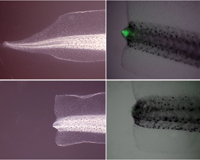Biologists at Tufts University’s School of Arts and Sciences, Medford, Massachusetts, have found a way to regenerate injured spinal cord and muscle by using small molecule drugs to trigger an influx of sodium ions into injured cells. Researchers are calling this a ground-breaking approach in biomedicine because it requires no gene therapy, can be administered after an injury has occurred and even after the wound has healed over, and is bioelectric, rather than chemically based.
The findings have tremendous implications for treating war wounds as well as accidental injuries. The treatment method used is most directly applicable to spinal cord repair and limb loss, according to a Tufts University press release. It also demonstrates a proof-of-principle that may be applicable to many complex organs and tissues. According to Tufts Director of Public Relations Kim Thurler, while the findings are promising, this approach is not being clinically applied at this point.

The tadpole on top, which received the “cocktail” to trigger an influx of sodium ions, grew a perfectly formed tail. The control tadpole on bottom did not regenerate. Photograph courtesy of Ai-Sun Tseng and Michael Levin, Tufts University.
In the cover story of the September 29, 2010, issue of the Journal of Neuroscience, the Tufts team reported that a localized increase in sodium ions was necessary for young Xenopus tadpoles to regenerate their tails-complex appendages containing spinal cord, muscle, and other tissue. Like human beings, who regenerate fingertips only as children, these tadpoles lose the ability to regenerate their tail with age. The tadpoles whose tails had been removed could regenerate a perfect new tail with only an hour of treatment with a specific drug cocktail. The discovery that the tail could be induced to regenerate as late as 18 hours after amputation revealed that tissues normally fated for regenerative failure still maintain their intrinsic characteristics and can be programmed to reactivate regeneration.
“We have significantly extended the effective treatment window, demonstrating that even after scar-like wound covering begins to form, control of physiological signals can still induce regeneration,” said Tufts Professor of Biology Michael Levin, PhD, corresponding author on the paper and director of the Tufts’ Center for Regenerative and Developmental Biology. “Artificially causing an influx of sodium for just one hour can overcome a variety of problems, such as the decline in regenerative ability that comes with age and the effect of regeneration-blocking drugs.”
The paper, titled “Induction of Vertebrate Regeneration by a Transient Sodium Current,” was co-authored by Research Associate Ai-Sun Tseng, Postdoctoral Associate Wendy S. Beane, Research Associate Joan M. Lemire, and Alessio Masi, a former post-doctoral associate in Levin’s laboratory. The National Institutes of Health, National Highway Traffic Safety Administration, U.S. Department of Defense and Defense Advanced Research Projects Agency funded the work.
Editor’s note: This story has been adapted from materials provided by Tufts University and the Journal of Neuroscience.




